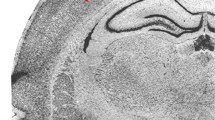Summary
Immunofluorescent studies of infection following intracerebral inoculation of LCM virus in neonatal mice show that virus spreads by contamination of cerebrospinal fluid and subcutaneous connective tissue, in addition to invasion of the bloodstream. Hematogenous dissemination involves the liver in 1 day, the spleen and kidneys in 2 days, and all remaining organs and tissues of the body, including the entire lymphoreticular system, in 3 days, with stability of the infection reached in 5 days. Hematogenous spread probably occurs via freely circulating plasma virus, since no virus is seen in red cells, and infected white cells appear only after the earliest peripheral tissue infection has already occurred.
Fluorescence in organs of older mice afflicted with “late disease” remains intense, and is indistinguishable in distribution from that seen in neonatal tolerant mice. Heaviest infection, occurring in the skin, gastrointestinal tract, and kidneys, explains the high degree of contagiousness noted in such animals, and may also be relevant to the pathogenesis of “late disease”, characterized by sparse and ruffled fur, weight loss, and glomerulonephritis. In particular, persistent viral proliferation in the kidneys may contribute to the virus-gamma globulin complexes coating and perhaps damaging the glomeruli.
Similar content being viewed by others
References
Hotchin, J., andH. Weigand: Studies of lymphocytic choriomeningitis in mice. I. The relationship between age at inoculation and outcome of infection. J. Immunol.86, 392 (1961).
Hotchin, J., andD. N. Collins: Glomerulonephritis and late disease of mice following neonatal virus infection. Nature (Lond.)203, 1357 (1964).
Baker, F. D., andJ. Hotchin: Slow virus kidney disease of mice. Science158, 502 (1967).
Oldstone, M. B. A., andF. J. Dixon: Lymphocytic choriomeningitis: production of antibody by “tolerant” infected mice. Science158, 1193 (1967).
Wilsnack, R. E., andW. P. Rowe: Immunofluorescent studies of the histopathogenesis of lymphocytic choriomeningitis virus infection. J. exp. Med.120, 829 (1964).
Mims, C. A.: Immunofluorescence study of the carrier state and mechanism of vertical transmission in lymphocytic choriomeningitis virus infection in mice. J. Path. Bact.91, 395 (1966).
Remezov, P. I., andK. A. Topleninova: Obnaruzhenie virusa limfotsitarnogo khoriomeningitas pomoshch'iu nepriamogo methoda fluorestsiruiushchikh antitel. Vop. Psikhiat. Nevropat.7, 113 (1961).
Author information
Authors and Affiliations
Rights and permissions
About this article
Cite this article
Brown, P. Evolution of lymphocytic choriomeningitis virus infection from neonatal inoculation through development of adult “late onset disease” and glomerulonephritis. Archiv f Virusforschung 24, 220–230 (1968). https://doi.org/10.1007/BF01241294
Received:
Issue Date:
DOI: https://doi.org/10.1007/BF01241294




